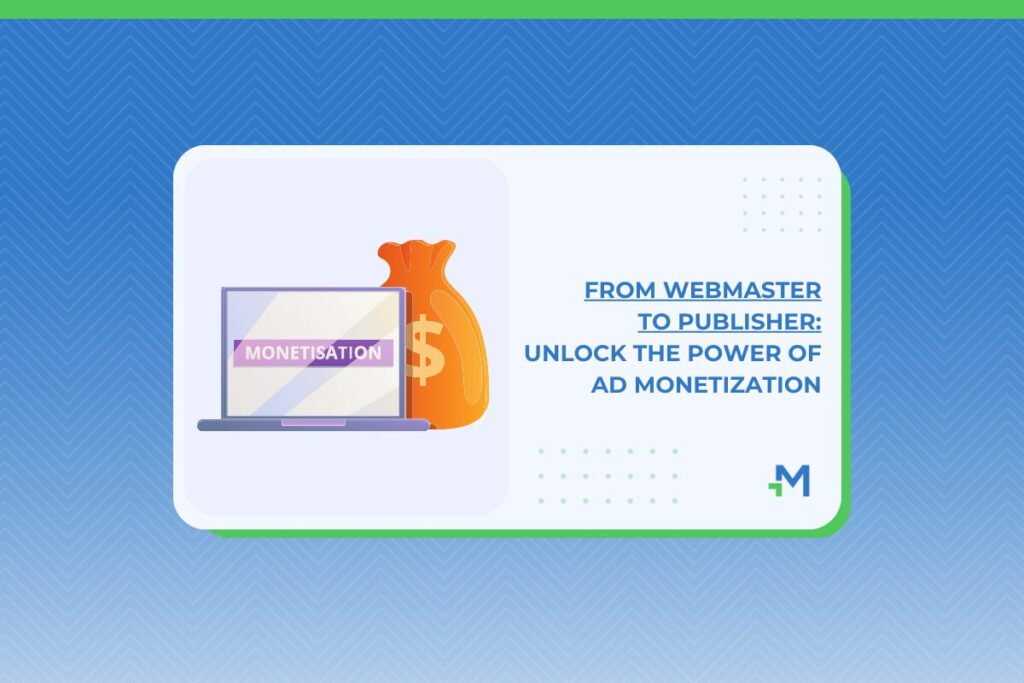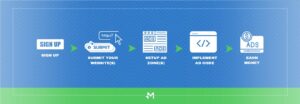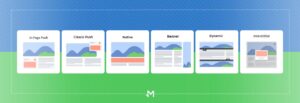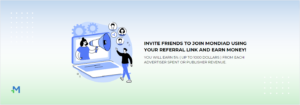As the digital landscape continues to evolve, the role of a webmaster is transforming into something more dynamic and lucrative. No longer just a manager of websites, webmasters are now stepping into the world of digital publishing, capitalizing on the growing opportunity of ad monetization.
However, building a successful website and generating substantial ad revenue takes time and effort. So, if you want to learn how millions of websites are earning money at this very moment, keep on reading to see what`s behind the wall of ad monetization!
[powerkit_toc title=”Table of Contents” depth=”2″ min_count=”4″ min_characters=”1000″ btn_hide=”false” default_state=”expanded”]
Understanding the Shift: From Webmaster to Publisher
Traditionally, a webmaster was responsible for the technical aspects of a website: maintaining its infrastructure, optimizing site performance, and ensuring it functioned seamlessly for users. The role often focused on site development and management, with limited involvement in content creation and revenue generation.
In contrast, a publisher is someone who not only manages the website but also focuses on content creation, audience building, and revenue generation through various forms of monetization, such as ads.
For many webmasters, the transition to a publisher is a natural one. With a focus on producing high-quality content and growing an engaged audience, webmasters can leverage their online presence to generate consistent income through ad networks(which acts as an intermediary between them and advertisers seeking space to display their ads), by simply integrating ads into their website.
The key is attracting and retaining a steady stream of visitors who will interact with the ads(whether through clicks, impressions, or conversions) generating revenue over time.
Why Ad Monetization Matters
To put it simply, ad monetization has become one of the most effective ways for publishers to turn their websites into sustainable revenue-generating assets. Which also comes with many perks:
Scalability:
As traffic grows, so do the opportunities for ad revenue. With tools like programmatic ads and automated campaign optimization, publishers can scale up their monetization efforts seamlessly.
Easy to Start:
Getting into ad monetization is straightforward, in a matter of minutes, making it an accessible revenue stream.
Low Time Investment:
Once set up, ad monetization doesn’t demand a lot of ongoing work, allowing you to focus on other tasks.
Work Remotely:
As long as you have a computer and internet connection, you can manage your ad campaigns from anywhere.
Recurring Income:
Ad revenue is ongoing, providing a steady stream of income over time.
Flexible Earnings:
Whether as a primary income source or a supplementary one, ad monetization offers flexibility to fit your needs.
How much money can you make?
If you rely on display advertising as your website monetization method, your earnings can range from a few dollars to a few hundred dollars per 1,000 website visits. However, the actual revenue will depend on factors such as the ad network you use, the ad type, the ad placement, the quality of your website traffic, the niche you’re in, and the overall performance of the ads.
If you have the means, you can check or ask around how things are going for other similar webmasters in your niche. The best way to see your potential though is to just get started and see for yourself. You have nothing to lose.
So the big question remains: “Is website monetization a choice for newbie ad publishers?”
1. Identify your people
The first step in making money via ad monetization is to identify your monetization potential. Believe it or not, it all starts with your audience. Who are your website visitors, how many of them are there and why are they coming back(if they do so -ideally, they should)? Answering all these questions will bring to the table several many ah-ha moments to guide you forward.
The more you know about your visitors, the better you can care for them. Audience insights will help you craft the right strategy to expand your website’s reach and simultaneously, its profitability.
Similarly, the more knowledgeable you are about your audience, the more attractive you’ll be in the eyes of advertisers. Having access to a growing pool of engaged website visitors brings you long-term steady ad revenue.
2. Audit your website ranking
You need to be patient and consistently provide value to your audience to attract and retain visitors, which, in turn, will make your website more appealing to advertisers.
Another key element affecting your monetization potential is your performance in search engine results. Organic traffic is needed to keep visitors coming to your website but for them to come, you must be as visible as possible and you must provide relevant information, engaging content and a positive user experience.
Keep nurturing your website with the right content and keep it coming since ranking is a dynamic process. Continue optimising your content with target keywords and relevant backlinks as well as creating high-quality content that engages your existing visitors. This method will keep them longer on your website and improve the ad views per user, which can in turn increase your ad revenue.
On the same note, maintain your website fast, responsive and mobile-friendly. Websites with a user-friendly experience show better ad performance and they are more likely to be chosen by advertisers.
3. Choose the right ad network
Assuming you have a decent volume of daily traffic for your website and you want to monetize it, it’s time you choose an ad network that would fulfil your ad revenue potential.
🔹 Traffic requirements
Generally, there is no specific minimum traffic threshold that applies universally, to all ad networks. It’s each with their own.
When choosing an ad network you should consider additional aspects like the ad formats available, cashout policy, payment options or overall user testimonials.
🔹 Registering eligibility
When considering joining an ad network as a publisher, you must ensure you comply with the platform’s terms of service and policies.
🔹 Ad formats
Another important aspect when choosing your ad network as a publisher is to ensure the ad formats serviced by the company align with your website’s niche and/or layout. As a webmaster, you’ll want to host ads that are relevant to your content and audience.
Look for a network that offers a variety of ad formats (banners, native ads, push notifications, popunders) that suit your website’s design and user experience.
🔹 Payout Terms & Frequency
Evaluate the ad network’s payment models and how they align with your traffic type.
- The CPM(Cost Per Mille) pricing type works best for brand awareness campaigns as publishers get paid for every 1,000 ad impressions, even if the user did not interact with the ad.
- The CPC(Cost Per Click) model, also known as PPC(Pay Per Click), pays publishers for the number of times a viewer clicks on an ad they host, to get further information on a product/service.
Cashout policies and payment processors are also crucial decision-makers when choosing an ad network for monetization. Having a website with lesser traffic will require time to reach a wider audience while the ad revenue potential fluctuates on many factors. For this reason, you’ll need an ad network that allows you low-end cashouts, frequent payments and several payment processors at your convenience, to be able to feel like you are in control of your earnings.
🔹Ad Relevance
The ads should be relevant to your audience. Irrelevant or intrusive ads can hurt your site’s user experience and lead to high bounce rates.
🔹 Analytics:
The ad network should provide detailed reports on your earnings, performance metrics, and traffic sources. Access to real-time analytics will help you optimize your ad placements.
4. Test out different ad formats
The best way to figure out your ad revenue potential as a new webmaster is via trial and error. Simply put, if you don’t have much experience with ad monetization yet, it’s time you play-test with several ad formats, placements and display options, to see which one(s)trigger the best results for your audience. Some ad types may perform better than others on your website, and different sizes may fit better with your website’s design.
Once implemented, don’t forget to monitor your impressions, clicks, CTR or any other relevant data, to make the next decisions well-informed.
5. Diversify your monetization options
Partnering with brands to create sponsored content can provide another source of income. This method is thought to be a bit tricky, especially for webmasters with smaller communities and experience. Influencer marketing however is a growing trend, so if the occasion arises, it’s a good idea to capitalize on it.
Participate in referral programs for products or services related to your website’s content. This is a widely used lucrative method for individuals to add another revenue stream to their pockets. If you’ve managed to build a community, referring it to relevant services will also benefit you, both personally and professionally.
Maximizing the Power of Your Audience
At the heart of successful ad monetization is a strong, engaged audience.
Content Quality:
Great content is still king. Focus on providing value to your readers through informative, entertaining, or problem-solving content that keeps them coming back.
User Experience:
Keep your website fast, mobile-friendly, and easy to navigate. The better the user experience, the more likely users are to interact with your ads.
Consistency:
Consistent publishing and engagement with your audience helps build trust and loyalty. A solid content calendar and active engagement on social media can keep your audience invested in your site.
The takeaway?
By embracing ad monetization, webmasters can unlock a new level of potential, turning their websites into thriving businesses. And the path to ad revenue is just a few clicks away.
When it comes to unlocking the power of ad monetization, striking the right balance between generating revenue and maintaining a positive user experience is key to long-term success.
Keep in mind that building a successful website with significant ad revenue takes time and persistence. Focus on creating valuable content and engaging your existing audience. As your traffic grows, you’ll see higher ad revenue especially if you run tests to understand what ad formats your audience prefers.
At the same time, while traffic is an essential factor in monetizing a website, it’s not the only consideration. Other factors such as your niche, your website design or your ad network of choice also play a crucial role in generating revenue.



